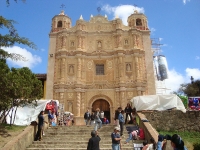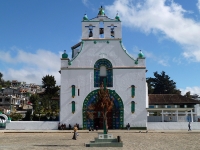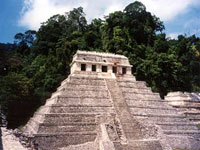Things to do in San Cristobal de las Casas
San Cristobal de las Casas is a rich cultural hub that has many intriguing attractions. The Na Bolom Cultural Centre is a wonderful place to learn a bit about the Lacandon people in a colourful and charming compound full of interesting artefacts and personal effects. The Museo de Trajes Regionales, a museum of Mayan textiles, is also a fantastic experience. The highland villages of San Juan Chamula and Zinacantan, home to the Tzotzil people who are descendants of the ancient Mayans, are nearby, but travellers should be very respectful and it's best to go with a local guide.
Other attractions worth seeking out in San Cristobal de las Casas include the Orquideas Moxviquil, a botanical garden sheltering more than 450 indigenous plant species, including some stunning and delicate specimens; as well as the fascinating Museo del Ambar (Amber Museum). Santo Domingo is the town's most beautiful church and although it's a little rundown, it's still definitely worth a visit. The main archaeological site in the area is the impressive ancient Mayan site of Palenque, the remains of a city dating back to the 7th century which many consider the most remarkable ancient Mayan site.

Santo Domingo
Blessed with an intricately carved pink Baroque facade that is especially impressive when lit up at night, Santo Domingo is the most beautiful of San Cristóbal's churches. The int…
Santo Domingo
Blessed with an intricately carved pink Baroque facade that is especially impressive when lit up at night, Santo Domingo is the most beautiful of San Cristóbal's churches. The interior is richly decorated, with the ornate pulpit and golden altarpieces being the main focus of this 16th-century architectural monument. Visitors are welcome at services but should prepare to be scolded by local worshippers if they don't show proper respect. The area in front and around the church is filled each day with craft stalls and village traders, and is a great place to find souvenirs such as woven blankets, shawls and amber jewellery.

San Juan Chamula and Zinacantan villages
These two highland villages are the home of the Tzotzil people, descendants of the ancient Mayans and some of Mexico's most traditional indigenous communities. San Juan Chamula is …
San Juan Chamula and Zinacantan villages
These two highland villages are the home of the Tzotzil people, descendants of the ancient Mayans and some of Mexico's most traditional indigenous communities. San Juan Chamula is a centre for religious festivals. The main attraction is the church where, every Sunday, men in loose homespun white woollen ponchos and women in embroidered finery congregate for the weekly market. The typical dress of the Zinacantan villagers is a red and white striped poncho decorated with tassels and a flat, round hat decorated with ribbons. The countryside is dotted with crosses and offerings dedicated to their ancestor gods or the Earth Lord. Visitors should respect the local traditions and customs; the best way to visit is with a local guide.

Palenque
The setting for this spectacular ancient Mayan city is splendid, a hauntingly beautiful site engulfed in the endless tropical jungle that bristles with the shrieks of insects. The …
Palenque
The setting for this spectacular ancient Mayan city is splendid, a hauntingly beautiful site engulfed in the endless tropical jungle that bristles with the shrieks of insects. The architecture is fantastic and, for many, Palenque is the most remarkable of the major Mayan sites. Early morning is the best time to capture the setting at its most photogenic, when swirling vapours encircle the temples and the jungle. The highlight is the tallest and most important of Palenque's buildings, the magnificent Temple of Inscriptions. Constructed on eight levels, the rear interior wall is decorated with panels of Mayan hieroglyphic inscriptions describing the history of Palenque and the temple. There is a museum near the entrance of the site.



